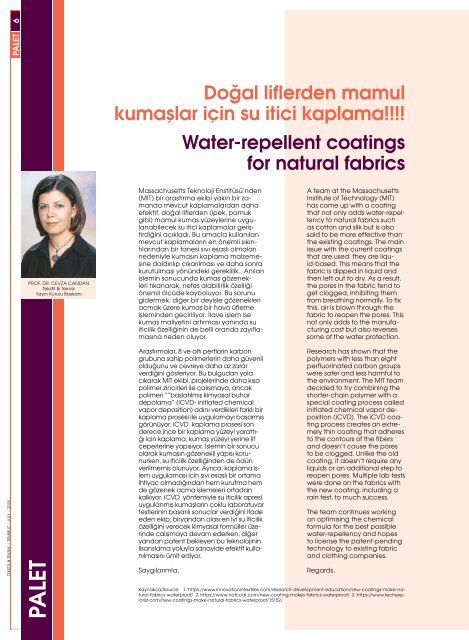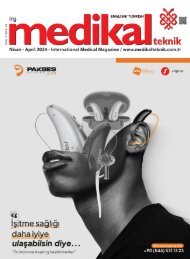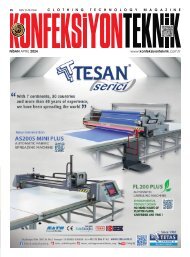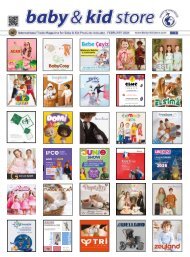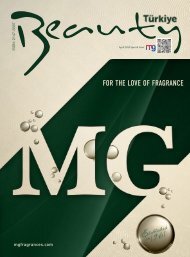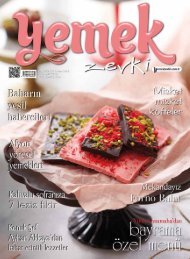You also want an ePaper? Increase the reach of your titles
YUMPU automatically turns print PDFs into web optimized ePapers that Google loves.
PALET<br />
6<br />
Doğal liflerden mamul<br />
kumaşlar için su itici kaplama!!!!<br />
Water-repellent coatings<br />
for natural fabrics<br />
PROF. DR. CEVZA CANDAN<br />
<strong>Tekstil</strong> & <strong>Teknik</strong><br />
Yayın Kurulu Başkanı<br />
Massachusetts Teknoloji Enstitüsü’nden<br />
(MIT) bir araştırma ekibi yakın bir zamanda<br />
mevcut kaplamalardan daha<br />
efektif, doğal liflerden (ipek, pamuk<br />
gibi) mamul kumaş yüzeylerine uygulanabilecek<br />
su itici kaplamalar geliştirdiğini<br />
açıkladı. Bu amaçla kullanılan<br />
mevcut kaplamaların en önemli sıkıntılarından<br />
bir tanesi sıvı esaslı olmaları<br />
nedeniyle kumaşın kaplama malzemesine<br />
daldırılıp çıkarılması ve daha sonra<br />
kurutulması yönündeki gereklilik. Anılan<br />
işlemin sonucunda kumaş gözenekleri<br />
tıkanarak, nefes alabilirlik özelliği<br />
önemli ölçüde kayboluyor. Bu sorunu<br />
gidermek, diğer bir deyişle gözenekleri<br />
açmak üzere kumaş bir hava üfleme<br />
işleminden geçiriliyor. İlave işlem ise<br />
kumaş maliyetini artırması yanında su<br />
iticilik özelliğinin de belli oranda zayıflamasına<br />
neden oluyor.<br />
A team at the Massachusetts<br />
Institute of Technology (MIT)<br />
has come up with a coating<br />
that not only adds water-repellency<br />
to natural fabrics such<br />
as cotton and silk but is also<br />
said to be more effective than<br />
the existing coatings. The main<br />
issue with the current coatings<br />
that are used: they are liquid-based.<br />
This means that the<br />
fabric is dipped in liquid and<br />
then left out to dry. As a result,<br />
the pores in the fabric tend to<br />
get clogged, inhibiting them<br />
from breathing normally. To fix<br />
this, air is blown through the<br />
fabric to reopen the pores. This<br />
not only adds to the manufacturing<br />
cost but also reverses<br />
some of the water protection.<br />
TEKSTİL & TEKNİK | TEMMUZ | JULY | 2018<br />
PALET<br />
Araştırmalar, 8 ve altı perflorin karbon<br />
grubuna sahip polimerlerin daha güvenli<br />
olduğunu ve çevreye daha az zarar<br />
verdiğini gösteriyor. Bu bulgudan yola<br />
çıkarak MIT ekibi, projelerinde daha kısa<br />
polimer zincirleri ile çalışmaya, ancak<br />
polimeri “”başlatılmış kimyasal buhar<br />
depolama” (iCVD- initiated chemical<br />
vapor deposition) adını verdikleri farklı bir<br />
kaplama prosesi ile uygulamayı başarmış<br />
görünüyor. iCVD kaplama prosesi son<br />
derece ince bir kaplama yüzeyi yarattığı<br />
için kaplama, kumaş yüzeyi yerine lif<br />
çeperlerine yapışıyor. İşlemin bir sonucu<br />
olarak kumaşın gözenekli yapısı korunurken,<br />
su iticilik özelliğinden de ödün<br />
verilmemiş olunuyor. Ayrıca, kaplama işlem<br />
uygulaması için sıvı esaslı bir ortama<br />
ihtiyaç olmadığından hem kurutma hem<br />
de gözenek açma işlemeleri ortadan<br />
kalkıyor. iCVD yöntemiyle su iticilik apresi<br />
uygulanmış kumaşların çoklu laboratuvar<br />
testlerinin başarılı sonuçlar verdiğini ifade<br />
eden ekip; biryandan olası en iyi su iticilik<br />
özelliğini verecek kimyasal formüller üzerinde<br />
çalışmaya devam ederken, diğer<br />
yandan patent bekleyen bu teknolojinin<br />
lisanslama yoluyla sanayide efektif kullanılmasını<br />
ümit ediyor.<br />
Saygılarımla,<br />
Research has shown that the<br />
polymers with less than eight<br />
perfluorinated carbon groups<br />
were safer and less harmful to<br />
the environment. The MIT team<br />
decided to try combining the<br />
shorter-chain polymer with a<br />
special coating process called<br />
initiated chemical vapor deposition<br />
(iCVD). The iCVD coating<br />
process creates an extremely<br />
thin coating that adheres<br />
to the contours of the fibers<br />
and doesn’t cause the pores<br />
to be clogged. Unlike the old<br />
coating, it doesn’t require any<br />
liquids or an additional step to<br />
reopen pores. Multiple lab tests<br />
were done on the fabrics with<br />
the new coating, including a<br />
rain test, to much success.<br />
The team continues working<br />
on optimising the chemical<br />
formula for the best possible<br />
water-repellency and hopes<br />
to license the patent-pending<br />
technology to existing fabric<br />
and clothing companies.<br />
Regards,<br />
Kaynakça/Source: 1. https://www.innovationintextiles.com/research-development-education/new-coatings-make-natural-fabrics-waterproof/<br />
2. https://www.natcoat.com/new-coating-makes-fabrics-waterproof/ 3. https://www.techexplorist.com/new-coatings-make-natural-fabrics-waterproof/15152/


